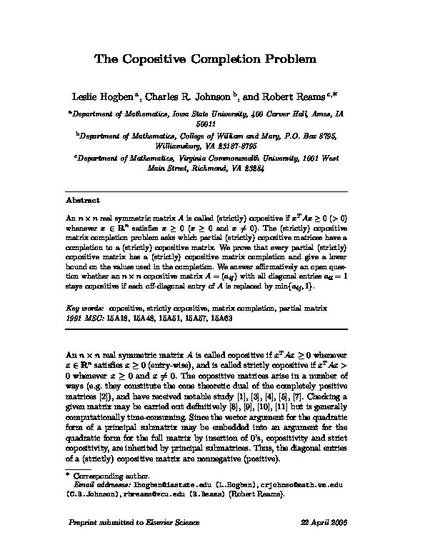
Article
The copositive completion problem
Linear Algebra and its Applications
Document Type
Article
Disciplines
Publication Version
Accepted Manuscript
Publication Date
10-1-2005
DOI
10.1016/j.laa.2005.06.019
Abstract
An n × n real symmetric matrix A is called (strictly) copositive if xTAx ⩾ 0 (>0) whenever x ∈ Rn satisfies x ⩾ 0 (x ⩾ 0 and x ≠ 0). The (strictly) copositive matrix completion problem asks which partial (strictly) copositive matrices have a completion to a (strictly) copositive matrix. We prove that every partial (strictly) copositive matrix has a (strictly) copositive matrix completion and give a lower bound on the values used in the completion. We answer affirmatively an open question whether an n × n copositive matrix A = (aij) with all diagonal entries aii = 1 stays copositive if each off-diagonal entry of A is replaced by min{aij, 1}.
Rights
This manuscript version is made available under the CCBY-NC-ND 4.0 license http://creativecommons.org/licenses/by-nc-nd/4.0/
Copyright Owner
Elsevier Inc.
Copyright Date
2005
Language
en
File Format
application/pdf
Citation Information
Leslie Hogben, Charles R. Johnson and Robert Reams. "The copositive completion problem" Linear Algebra and its Applications Vol. 408 (2005) Available at: http://works.bepress.com/leslie-hogben/69/

This is a manuscript of an article from Linear Algebra and its Applications 408 (2005): 207, doi:10.1016/j.laa.2005.06.019. Posted with permission.